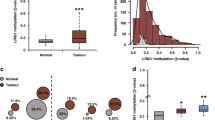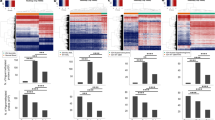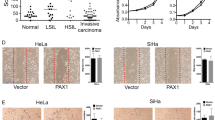Abstract
The calcium-activated chloride channel gene family is clustered in the 1p31 region, which is frequently deleted in sporadic breast cancer. Recent studies have indicated the association of the second member of this gene family (CLCA2) with the development of breast cancer and metastasis. We have now shown the absence of expression of CLCA2 in several breast cancer tumours and cell lines, which confirms the results from other reports. When overexpressed in CLCA2-negative cell lines, their tumorigenicity and metastasis capability were significantly reduced, suggesting a tumour suppressor role for CLCA2 in breast cancer. The mechanisms behind the silencing of CLCA2 in breast cancer, however, have not been elucidated to date. Although we were able to identify CLCA2 mutations in breast cancers, somatic mutations are not the major cause of CLCA2 gene silencing. On the other hand, treatment of breast cancer CLCA2-negative cell lines with demethylating agents was able to restore CLCA2 expression, suggesting an epigenetic inactivation of this gene. Bisulphite-sequencing of the promoter-associated CpG island of the CLCA2 gene in breast tumours demonstrated that the absence of expression in these tumours was caused by hypermethylation of the promoter CpG island. In contrast, in breast cancer cell lines, tumours, and control cell lines that express CLCA2, a much lower level, and often absence, of methylation of the promoter were demonstrated. These findings demonstrate that CLCA2 is frequently inactivated in breast cancer by promoter region hypermethylation, which makes it an excellent candidate for the 1p31 breast cancer tumour suppressor gene.
This is a preview of subscription content, access via your institution
Access options
Subscribe to this journal
Receive 50 print issues and online access
$259.00 per year
only $5.18 per issue
Buy this article
- Purchase on Springer Link
- Instant access to full article PDF
Prices may be subject to local taxes which are calculated during checkout





Similar content being viewed by others
References
Abdollahi A, Pisarcik D, Roberts D, Weinstein J, Cairns P and Hamilton TC . (2003). J. Biol. Chem., 278, 6041–6049.
Agnel M, Vermat T and Culouscou JM . (1999). FEBS Lett., 455, 295–301.
Antequera F, Boyes J and Bird A . (1990). Cell, 62, 503–514.
Antoniou A, Pharoah PD, Narod S, Risch HA, Eyfjord JE, Hopper JL, Loman N, Olsson H, Johannsson O, Borg A, Pasini B, Radice P, Manoukian S, Eccles DM, Tang N, Olah E, Anton-Culver H, Warner E, Lubinski J, Gronwald J, Gorski B, Tulinius H, Thorlacius S, Eerola H, Nevanlinna H, Syrjakoski K, Kallioniemi OP, Thompson D, Evans C, Peto J, Lalloo F, Evans DG and Easton DF . (2003). Am. J. Hum. Genet., 72, 1117–1130.
Baylin SB and Herman JG . (2000). Trends Genet., 16, 168–174.
Bird A . (2002). Genes Dev., 16, 6–21.
Bubien JK, Kirk KL, Rado TA and Frizzell RA . (1990). Science, 248, 1416–1419.
Catteau A, Harris WH, Xu CF and Solomon E . (1999). Oncogene, 18, 1957–1965.
Cavenee WK, Dryja TP, Phillips RA, Benedict WF, Godbout R, Gallie BL, Murphree AL, Strong LC and White RL . (1983). Nature, 305, 779–784.
Clark SJ, Harrison J, Paul CL and Frommer M . (1994). Nucleic Acids Res., 22, 2990–2997.
Collins FS . (1992). Nat. Genet., 1, 3–6.
Dallol A, Da Silva NF, Viacava P, Minna JD, Bieche I, Maher ER and Latif F . (2002). Cancer Res., 62, 5874–5880.
Dammann R, Schagdarsurengin U, Strunnikova M, Rastetter M, Seidel C, Liu L and Pfeifer GP . (2003). Histol. Histopathol., 18, 665–677.
Deane KH and Mannie MD . (1992). Eur. J. Immunol., 22, 1165–1171.
Elble RC and Pauli BU . (2001). J. Biol. Chem., 276, 40510–40517.
Esteller M . (2002). Oncogene, 21, 5427–5440.
Frommer M, McDonald LE, Millar DS, Collis CM, Watt F, Grigg GW, Molloy PL and Paul CL . (1992). Proc. Natl. Acad. Sci. USA, 89, 1827–1831.
Garinis GA, Patrinos GP, Spanakis NE and Menounos PG . (2002). Hum. Genet., 111, 115–127.
Grigg G and Clark S . (1994). Bioessays, 16, 431–436.
Gruber AD, Elble RC, Ji HL, Schreur KD, Fuller CM and Pauli BU . (1998). Genomics, 54, 200–214.
Gruber AD and Pauli BU . (1999). Cancer Res., 59, 5488–5491.
Gruber AD, Schreur KD, Ji HL, Fuller CM and Pauli BU . (1999). Am. J. Physiol., 276, 1261–1270.
Hoff C, Mollenhauer J, Waldau B, Hamann U and Poustka A . (2001). Cancer Genet. Cytogenet., 129, 145–149.
Hoggard N, Hey Y, Brintnell B, James L, Jones D, Mitchell E, Weissenbach J and Varley JM . (1995). Genomics, 30, 233–243.
Holliday R and Grigg GW . (1993). Mutat. Res., 285, 61–67.
Lichy JH, Zavar M, Tsai MM, O'Leary TJ and Taubenberger JK . (1998). Am. J. Pathol., 153, 5–9.
Nagai H, Negrini M, Carter SL, Gillum DR, Rosenberg AL, Schwartz GF and Croce C . (1995). Cancer Res., 55, 1752–1757.
Pauli BU, Abdel-Ghany M, Cheng HC, Gruber AD, Archibald HA and Elble RC . (2002). Clin. Exp. Pharmacol. Physiol., 27, 901–905.
Roy D, Calaf G and Hei TK . (2003). Int. J. Cancer, 103, 730–737.
Sossey-Alaoui K, Kitamura E and Cowell JK . (2001). Int. J. Mol. Med., 7, 543–546.
Sossey-Alaoui K, Kitamura E, Head K and Cowell JK . (2002a). Genomics, 80, 5–7.
Sossey-Alaoui K, Su G, Malaj E, Roe B and Cowell JK . (2002b). Oncogene, 21, 5967–5974.
Soule HD, Maloney TM, Wolman SR, Peterson Jr WD, Brenz R, McGrath CM, Russo J, Pauley RJ, Jones RF and Brooks SC . (1990). Cancer Res., 50, 6075–6086.
Su G, Roberts T and Cowell JK . (1999). Genomics, 55, 157–1563.
Tsukamoto K, Ito N, Yoshimoto M, Kasumi F, Akiyama F, Sakamoto G, Nakamura Y and Emi M . (1998). Cancer, 82, 317–322.
Ullrich N and Sontheimer H . (1997). Am. J. Physiol., 273, 1290–1297.
White GR, Varley JM and Heighway J . (1998). Oncogene, 17, 3513–3519.
Zochbauer-Muller S, Fong KM, Maitra A, Lam S, Gerads J, Ashfaq R, Virmani AK, Milchgrub S, Gazdar AF and Minna JD . (2001). Cancer Res., 61, 3581–3585.
Acknowledgements
We thank Dr Harold Asch for kindly providing the breast tumour samples; Natacha Diaz Meyer for helpful input; Michelle Detwiller, MS and Shakeeba Waseh, BS for their technical assistance. This work was supported in part by a grant (DAMD17-98-1-8294) from the United States Department of Defense (to JKC), by an Institutional Research Grant (IRG-02-197-01) from the American Cancer Society (to KSA), by a Cancer Center Support Grant (CA16056) from the National Cancer Institute (to Roswell Park Cancer Institute).
Author information
Authors and Affiliations
Corresponding author
Rights and permissions
About this article
Cite this article
Li, X., Cowell, J. & Sossey-Alaoui, K. CLCA2 tumour suppressor gene in 1p31 is epigenetically regulated in breast cancer. Oncogene 23, 1474–1480 (2004). https://doi.org/10.1038/sj.onc.1207249
Received:
Revised:
Accepted:
Published:
Issue Date:
DOI: https://doi.org/10.1038/sj.onc.1207249
Keywords
This article is cited by
-
Gene network analysis to determine the effect of hypoxia-associated genes on brain damages and tumorigenesis using an avian model
Journal of Genetic Engineering and Biotechnology (2021)
-
TPSC: a module detection method based on topology potential and spectral clustering in weighted networks and its application in gene co-expression module discovery
BMC Bioinformatics (2021)
-
The calcium-activated chloride channel-associated protein rCLCA2 is expressed throughout rat epidermis, facilitates apoptosis and is downmodulated by UVB
Histochemistry and Cell Biology (2021)
-
CLCA1 suppresses colorectal cancer aggressiveness via inhibition of the Wnt/beta-catenin signaling pathway
Cell Communication and Signaling (2017)
-
Maintaining the unmethylated state
Clinical Epigenetics (2013)



